Using the WWF Water Risk Filter to Screen Existing and Projected Hydropower Projects for Climate and Biodiversity Risks
Abstract
1. Introduction
2. Materials and Methods
2.1. Hydropower Dams Data
2.2. Water Risk Filter Data
2.2.1. Water Scarcity
2.2.2. Flooding
2.2.3. Biodiversity
2.3. Assessment of Climate-Related Hydrological and Biodiversity Risks for Hydropower
3. Results
3.1. Existing Hydropower Dams and Changes in Water Scarcity Risk
3.2. Existing Hydropower Dams and Changes in Flood Risk
3.3. Projected Dams and Changes in Water Scarcity Risk
3.4. Projected Dams and Changes in Flood Risk
3.5. Hydropower Dams and the Interaction of Projected Water Scarcity and Flood Risk
3.6. Hydropower Dams and Freshwater Biodiversity Risk
3.7. Hydropower Dams and the Interaction of Projected Water Scarcity and Freshwater Biodiversity
4. Discussion
4.1. Risks for Hydropower Projects and Systems: Water Scarcity, Floods, and Biodiversity
4.2. Hydrological Risks and Financial and Economic Risks for Hydropower Projects and Systems
4.3. Options for Hydropower Planning and Management to Address Risk
- Hydropower should be planned within broad energy system planning processes that can assess multiple potential pathways (e.g., different combinations of technologies for generation and storage) and can compare how those options perform across a range of objectives. These processes should use scenario analysis to incorporate potential future climate-driven hydrological changes.
- Diversify the regional power pool to reduce dependency on hydropower that could be vulnerable to droughts.
- Hydropower dams should be planned and managed at the basin or regional scale, integrated with other sectors and resources.
- Periodic relicensing provides the opportunity to revise the operations of existing hydropower projects, accounting for climate change as well as changes in objectives for other resources. System-scale approaches may increase the range of solutions available during the rebalancing process afforded by relicensing.
- Invest in hydropower infrastructure that is reversible and/or resilient/adaptable. Increase the flexibility of dam operations through operation rules and design, such as the incorporation of a broader range of turbine sizes or multiple outlets, to increase the range of flows and water temperatures that a dam can release.
- Include larger safety margins for new dams and, where needed, retrofit existing dams to reduce risks from flooding (e.g., increased spillway capacity for potentially larger floods).
5. Conclusions
Author Contributions
Funding
Institutional Review Board Statement
Informed Consent Statement
Data Availability Statement
Conflicts of Interest
References
- Barbarossa, V.; Bosmans, J.; Wanders, N.; King, H.; Bierkens, M.F.P.; Huijbregts, M.A.J.; Schipper, A.M. Threats of Global Warming to the World’s Freshwater Fishes. Nat. Commun. 2021, 12, 1701. [Google Scholar] [CrossRef] [PubMed]
- Cai, W.; Cowan, T. Evidence of Impacts from Rising Temperature on Inflows to the Murray-Darling Basin. Geophys. Res. Lett. 2008, 35. [Google Scholar] [CrossRef]
- van Vliet, M.T.H.; Franssen, W.H.P.; Yearsley, J.R.; Ludwig, F.; Haddeland, I.; Lettenmaier, D.P.; Kabat, P. Global River Discharge and Water Temperature under Climate Change. Glob. Environ. Change 2013, 23, 450–464. [Google Scholar] [CrossRef]
- Gleick, P.H.; Chalecki, E.L. The Impacts of Climatic Changes for Water Resources of the Colorado and Sacramento-San Joaquin River Basins. JAWRA J. Am. Water Resour. Assoc. 1999, 35, 1429–1441. [Google Scholar] [CrossRef]
- Barnett, T.P.; Adam, J.C.; Lettenmaier, D.P. Potential Impacts of a Warming Climate on Water Availability in Snow-Dominated Regions. Nature 2005, 438, 303–309. [Google Scholar] [CrossRef]
- Mamalakis, A.; Randerson, J.T.; Yu, J.-Y.; Pritchard, M.S.; Magnusdottir, G.; Smyth, P.; Levine, P.A.; Yu, S.; Foufoula-Georgiou, E. Zonally Contrasting Shifts of the Tropical Rain Belt in Response to Climate Change. Nat. Clim. Change 2021, 11, 1–9. [Google Scholar] [CrossRef]
- Durack, P.J.; Wijffels, S.E.; Matear, R.J. Ocean Salinities Reveal Strong Global Water Cycle Intensification during 1950 to 2000. Science 2012, 336, 455–458. [Google Scholar] [CrossRef]
- Kundzewicz, Z.W.; Mata, L.; Arnell, N.W.; Döll, P.; Jimenez, B.; Miller, K.; Oki, T.; Şen, Z.; Shiklomanov, I. The Implications of Projected Climate Change for Freshwater Resources and Their Management. Hydrol. Sci. J. 2008, 53, 3–10. [Google Scholar] [CrossRef]
- Grill, G.; Lehner, B.; Thieme, M.; Geenen, B.; Tickner, D.; Antonelli, F.; Babu, S.; Borrelli, P.; Cheng, L.; Crochetiere, H.; et al. Mapping the World’s Free-Flowing Rivers. Nature 2019, 569, 215–221. [Google Scholar] [CrossRef]
- World Commission on Dams Dams and Development: A New Framework for Decision-Making: The Report of the World Commission on Dams; Earthscan: London, UK, 2000; ISBN 978-1-85383-798-2.
- Syvitski, J.P.M. Deltas at Risk. Sustain. Sci. 2008, 3, 23–32. [Google Scholar] [CrossRef]
- Syvitski, J.P.M.; Kettner, A.J.; Overeem, I.; Hutton, E.W.H.; Hannon, M.T.; Brakenridge, G.R.; Day, J.; Vörösmarty, C.; Saito, Y.; Giosan, L.; et al. Sinking Deltas Due to Human Activities. Nat. Geosci. 2009, 2, 681–686. [Google Scholar] [CrossRef]
- Dunn, F.E.; Darby, S.E.; Nicholls, R.J.; Cohen, S.; Zarfl, C.; Fekete, B.M. Projections of Declining Fluvial Sediment Delivery to Major Deltas Worldwide in Response to Climate Change and Anthropogenic Stress. Environ. Res. Lett. 2019, 14, 084034. [Google Scholar] [CrossRef]
- Palmer, M.A.; Liermann, C.A.R.; Nilsson, C.; Flörke, M.; Alcamo, J.; Lake, P.S.; Bond, N. Climate Change and the World’s River Basins: Anticipating Management Options. Front. Ecol. Environ. 2008, 6, 81–89. [Google Scholar] [CrossRef]
- IEA World Energy Outlook 2020; International Energy Agency: Paris, France, 2020.
- Opperman, J.; Hartmann, J.; Harrison, D. Hydropower within the Climate, Energy and Water Nexus. In Climate, Energy and Water: Managing Trade-offs, Seizing Opportunities; Dovers, S., Hussey, K., Pittock, J., Eds.; Cambridge University Press: Cambridge, UK, 2015; pp. 79–107. [Google Scholar]
- Opperman, J.; Hartmann, J.; Lambrides, M.; Carvallo, J.; Chapin, E.; Baruch-Mordo, S.; Eyler, B.; Goichot, M.; Harou, J.; Hepp, J. Connected and Flowing: A Renewable Future for Rivers, Climate, and People; WWF and The Nature Conservancy: Washington, DC, USA, 2019. [Google Scholar]
- Opperman, J.; Baruch-Mordo, S.; Carvallo, J.; Kammen, D.; Kiesecker, J.; Weber, C. Sustaining the Last Rivers. Am. Sci. 2019, 107, 302. [Google Scholar] [CrossRef]
- Ansar, A.; Flyvbjerg, B.; Budzier, A.; Lunn, D. Should We Build More Large Dams? The Actual Costs of Hydropower Megaproject Development. Energy Policy 2014, 69, 43–56. [Google Scholar] [CrossRef]
- IPCC. Global Warming of 1.5 °C; Intergovernmental Panel on Climate Change: Geneva, Switzerland, 2018. [Google Scholar]
- IEA. Net Zero by 2050—A Roadmap for the Global Energy Sector; International Energy Agency: Paris, France, 2021. [Google Scholar]
- International Renewable Energy Agency. World Energy Transitions Outlook: 1.5 °C Pathway; International Renewable Energy Agency: Abu Dhabi, United Arab Emirates, 2021. [Google Scholar]
- Von Randow, R.C.S.; Rodriguez, D.A.; Tomasella, J.; Aguiar, A.P.D.; Kruijt, B.; Kabat, P. Response of the River Discharge in the Tocantins River Basin, Brazil, to Environmental Changes and the Associated Effects on the Energy Potential. Reg. Environ. Change 2019, 19, 193–204. [Google Scholar] [CrossRef]
- Beilfuss, D.R. A Risky Climate for Southern African Hydro; International Rivers: Berkeley, CA, USA, 2012; p. 60. [Google Scholar]
- van Vliet, M.T.H.; Wiberg, D.; Leduc, S.; Riahi, K. Power-Generation System Vulnerability and Adaptation to Changes in Climate and Water Resources. Nat. Clim. Change 2016, 6, 375–380. [Google Scholar] [CrossRef]
- Latrubesse, E.M.; Park, E.; Sieh, K.; Dang, T.; Lin, Y.N.; Yun, S.-H. Dam Failure and a Catastrophic Flood in the Mekong Basin (Bolaven Plateau), Southern Laos, 2018. Geomorphology 2020, 362, 107221. [Google Scholar] [CrossRef]
- Beggin, R. Midland Failed Dams, Floods Caused $200M in Damages to 2500 Buildings. Bridge Michigan. 2020. Available online: https://www.bridgemi.com/michigan-government/midland-failed-dams-floods-caused-200m-damages-2500-buildings (accessed on 21 January 2022).
- Opperman, J.; Hartmann, J.; Raepple, J.; Angarita, H.; Beames, P.; Chapin, E.; Geressu, R.; Grill, G.; Harou, J.; Hurford, A.; et al. The Power of Rivers: A Business Case; The Nature Conservancy: Arlington, VA, USA, 2017. [Google Scholar]
- Opperman, J.J.; Grill, G.; Hartmann, J. The Power of Rivers; The Nature Conservancy: Arlington, VA, USA, 2015. [Google Scholar]
- Milly, P.C.D.; Betancourt, J.; Falkenmark, M.; Hirsch, R.M.; Kundzewicz, Z.W.; Lettenmaier, D.P.; Stouffer, R.J. Stationarity Is Dead: Whither Water Management? Science 2008, 319, 573–574. [Google Scholar] [CrossRef]
- Poff, N.L.; Brown, C.M.; Grantham, T.E.; Matthews, J.H.; Palmer, M.A.; Spence, C.M.; Wilby, R.L.; Haasnoot, M.; Mendoza, G.F.; Dominique, K.C.; et al. Sustainable Water Management under Future Uncertainty with Eco-Engineering Decision Scaling. Nat. Clim. Change 2016, 6, 25–34. [Google Scholar] [CrossRef]
- Matthews, J.H.; Wickel, B.A.J.; Freeman, S. Converging Currents in Climate-Relevant Conservation: Water, Infrastructure, and Institutions. PLoS Biol. 2011, 9, e1001159. [Google Scholar] [CrossRef]
- WWF; WBCSD. Right Tool for the Job: Tools and Approaches for Companies and Investors to Assess Water Risks and Shared Water Challenges; The World Wildlife Fund (WWF) and the World Business Council for Sustainable Development (WBCSD): Washington, DC, USA, 2020. [Google Scholar]
- Ebinger, J.; Vergara, W. Climate Impacts on Energy Systems; World Bank Studies; The World Bank: Washington, DC, USA, 2011; ISBN 978-0-8213-8697-2. [Google Scholar]
- Hallegatte, S. Strategies to Adapt to an Uncertain Climate Change. Glob. Environ. Change 2009, 19, 240–247. [Google Scholar] [CrossRef]
- Hallegatte, S.; Rentschler, J.; Rozenberg, J. Adaptation Principles: A Guide for Designing Strategies for Climate Change Adaptation and Resilience; The World Bank: Washington, DC, USA, 2020. [Google Scholar]
- ICOLD. Dam Safety Management; International Commission on Large Dams: Paris, France, 2021. [Google Scholar]
- ICOLD. Flood Evaluation and Dam Safety; International Commission on Large Dams: Paris, France, 2018. [Google Scholar]
- International Hydropower Association. Hydropower Sector Climate Resilience Guide; International Hydropower Association: London, UK, 2019. [Google Scholar]
- Karki, P.; Bonzanigo, L.; Ohtsuka, H.; Pahuja, S. Toward Climate-Resilient Hydropower in South Asia; The World Bank: Washington, DC, USA, 2016. [Google Scholar]
- Lehner, B.; Liermann, C.R.; Revenga, C.; Vörösmarty, C.; Fekete, B.; Crouzet, P.; Döll, P.; Endejan, M.; Frenken, K.; Magome, J.; et al. High-resolution Mapping of the World’s Reservoirs and Dams for Sustainable River-flow Management. Front. Ecol. Environ. 2011, 9, 494–502. [Google Scholar] [CrossRef]
- Zarfl, C.; Lumsdon, A.E.; Berlekamp, J.; Tydecks, L.; Tockner, K. A Global Boom in Hydropower Dam Construction. Aquat. Sci. 2015, 77, 161–170. [Google Scholar] [CrossRef]
- Schulte, P.; Morrison, J. Driving Harmonization of Water-Related Terminology. CEO Water Mandate Discussion Paper; Pacific Institute: Oakland, CA, USA, 2014. [Google Scholar]
- Laporte-Bisquit, A. WWF Water Risk Filter: Assess, Respond & Value Water Risks. In Sustainable Industrial Water Use: Perspecitves, Incentives, Tools; IWA Publishing: London, UK, 2021. [Google Scholar] [CrossRef]
- Lehner, B.; Grill, G. Global River Hydrography and Network Routing: Baseline Data and New Approaches to Study the World’s Large River Systems. Hydrol. Processes 2013, 27, 2171–2186. [Google Scholar] [CrossRef]
- IPCC. AR5 Synthesis Report: Climate Change 2014; Intergovernmental Panel on Climate Change (IPCC): Geneva, Switzerland, 2014. [Google Scholar]
- O’Neill, B.C.; Kriegler, E.; Ebi, K.L.; Kemp-Benedict, E.; Riahi, K.; Rothman, D.S.; van Ruijven, B.J.; van Vuuren, D.P.; Birkmann, J.; Kok, K.; et al. The Roads Ahead: Narratives for Shared Socioeconomic Pathways Describing World Futures in the 21st Century. Glob. Environ. Change 2017, 42, 169–180. [Google Scholar] [CrossRef]
- Riahi, K.; van Vuuren, D.P.; Kriegler, E.; Edmonds, J.; O’Neill, B.C.; Fujimori, S.; Bauer, N.; Calvin, K.; Dellink, R.; Fricko, O.; et al. The Shared Socioeconomic Pathways and Their Energy, Land Use, and Greenhouse Gas Emissions Implications: An Overview. Glob. Environ. Change 2017, 42, 153–168. [Google Scholar] [CrossRef]
- Hoekstra, A.Y.; Chapagain, A.K. Water Footprints of Nations: Water Use by People as a Function of Their Consumption Pattern. In Integrated Assessment of Water Resources and Global Change: A North-South Analysis; Craswell, E., Bonnell, M., Bossio, D., Demuth, S., Van De Giesen, N., Eds.; Springer: Dordrecht, The Netherlands, 2007; pp. 35–48. ISBN 978-1-4020-5591-1. [Google Scholar]
- Trabucco, A.; Zomer, R. Global Aridity Index and Potential Evapotranspiration (ET0) Climate Database V2. 2019. Available online: https://doi.org/10.6084/m9.figshare.7504448.v3 (accessed on 21 January 2022).
- Brauman, K.A.; Richter, B.D.; Postel, S.; Malsy, M.; Flörke, M. Water Depletion: An Improved Metric for Incorporating Seasonal and Dry-Year Water Scarcity into Water Risk Assessments. Elem. Sci. Anthr. 2016, 4, 83. [Google Scholar] [CrossRef]
- Hofste, R.; Kuzma, S.; Walker, S.; Sutanudjaja, E.; Bierkens, M.; Kuijper, M.; Faneca Sanchez, M.; Van Beek, R.; Wada, Y.; Galvis Rodríguez, S.; et al. Aqueduct 3.0: Updated Decision-Relevant Global Water Risk Indicators; World Recources Insititute: Washington, DC, USA, 2019. [Google Scholar] [CrossRef]
- Mekonnen, M.M.; Hoekstra, A.Y. Four Billion People Facing Severe Water Scarcity. Sci. Adv. 2016, 2, e1500323. [Google Scholar] [CrossRef]
- Boulay, A.-M.; Bare, J.; Benini, L.; Berger, M.; Lathuillière, M.J.; Manzardo, A.; Margni, M.; Motoshita, M.; Núñez, M.; Pastor, A.V.; et al. The WULCA Consensus Characterization Model for Water Scarcity Footprints: Assessing Impacts of Water Consumption Based on Available Water Remaining (AWARE). Int. J. Life Cycle Assess. 2018, 23, 368–378. [Google Scholar] [CrossRef]
- Vicente-Serrano, S.M.; Beguería, S.; López-Moreno, J.I. A Multiscalar Drought Index Sensitive to Global Warming: The Standardized Precipitation Evapotranspiration Index. J. Clim. 2010, 23, 1696–1718. [Google Scholar] [CrossRef]
- Frieler, K.; Lange, S.; Piontek, F.; Reyer, C.P.O.; Schewe, J.; Warszawski, L.; Zhao, F.; Chini, L.; Denvil, S.; Emanuel, K.; et al. Assessing the Impacts of 1.5 °C Global Warming—Simulation Protocol of the Inter-Sectoral Impact Model Intercomparison Project (ISIMIP2b). Geosci. Model Dev. 2017, 10, 4321–4345. [Google Scholar] [CrossRef]
- Greve, P.; Kahil, T.; Mochizuki, J.; Schinko, T.; Satoh, Y.; Burek, P.; Fischer, G.; Tramberend, S.; Burtscher, R.; Langan, S.; et al. Global Assessment of Water Challenges under Uncertainty in Water Scarcity Projections. Nat. Sustain. 2018, 1, 486–494. [Google Scholar] [CrossRef]
- Kummu, M.; Fader, M.; Gerten, D.; Guillaume, J.H.; Jalava, M.; Jägermeyr, J.; Pfister, S.; Porkka, M.; Siebert, S.; Varis, O. Bringing It All Together: Linking Measures to Secure Nations’ Food Supply. Curr. Opin. Environ. Sustain. 2017, 29, 98–117. [Google Scholar] [CrossRef]
- Brakenridge, G.R. Global Active Archive of Large Flood Events; Dartmouth Flood Observatory, University of Colorado: Boulder, CO, USA, 2020. [Google Scholar]
- Hirabayashi, Y.; Mahendran, R.; Koirala, S.; Konoshima, L.; Yamazaki, D.; Watanabe, S.; Kim, H.; Kanae, S. Global Flood Risk under Climate Change. Nat. Clim. Change 2013, 3, 816–821. [Google Scholar] [CrossRef]
- Abell, R.; Thieme, M.L.; Revenga, C.; Bryer, M.; Kottelat, M.; Bogutskaya, N.; Coad, B.; Mandrak, N.; Balderas, S.C.; Bussing, W.; et al. Freshwater Ecoregions of the World: A New Map of Biogeographic Units for Freshwater Biodiversity Conservation. BioScience 2008, 58, 403–414. [Google Scholar] [CrossRef]
- Turner, S.W.D.; Ng, J.Y.; Galelli, S. Examining Global Electricity Supply Vulnerability to Climate Change Using a High-Fidelity Hydropower Dam Model. Sci. Total Environ. 2017, 590–591, 663–675. [Google Scholar] [CrossRef]
- Connell-Buck, C.R.; Medellín-Azuara, J.; Lund, J.R.; Madani, K. Adapting California’s Water System to Warm vs. Dry Climates. Clim. Change 2011, 109, 133–149. [Google Scholar] [CrossRef]
- Madani, K.; Lund, J.R. Modeling California’s High-Elevation Hydropower Systems in Energy Units. Water Resour. Res. 2009, 45. [Google Scholar] [CrossRef]
- MacDonald, E.M. Integrated Water Resources Management Strategy and Implementation Plan for the Zambezi River Basin. SADC-WD/Zambezi River Authority. 2008. Available online: https://zambezicommission.org/sites/default/files/clusters_pdfs/Zambezi%20River_Basin_IWRM_Strategy_ZAMSTRAT.pdf (accessed on 21 January 2022).
- Saunders, S.; Findlay, D.; Easley, T.; Spencer, T. Doubled Trouble: More Midwestern Extreme Storms; The Rocky Mountain Climate Organization and the Natural Resources Defense Council: Washington, DC, USA, 2012; pp. 409–419. [Google Scholar]
- Lall, U.; Larrauri, P.C. The Michigan Dam Failures Are a Warning. The New York Times, 27 May 2020. [Google Scholar]
- Perera, D.; Smakhtin, V.; Williams, S.; North, T.; Curry, A. Ageing Water Storage Infrastructure: An Emerging Global Risk; UNU-INWEH Report Series; Issue 11, United Nations University: Tokyo, Japan, 2021. [Google Scholar]
- Lee, J.; Hamlet, A.; Asce, M.; Fitzgerald, C.; Burges, S.; Asce, F. Optimized Flood Control in the Columbia River Basin for a Global Warming Scenario. J. Water Resour. Plan. Manag. 2009, 135. [Google Scholar] [CrossRef]
- Payne, J.T.; Wood, A.W.; Hamlet, A.F.; Palmer, R.N.; Lettenmaier, D.P. Mitigating the Effects of Climate Change on the Water Resources of the Columbia River Basin. Clim. Change 2004, 62, 233–256. [Google Scholar] [CrossRef]
- Yates, D.; Galbraith, H.; Purkey, D.; Huber-Lee, A.; Sieber, J.; West, J.; Herrod-Julius, S.; Joyce, B. Climate Warming, Water Storage, and Chinook Salmon in California’s Sacramento Valley. Clim. Change 2008, 91, 335. [Google Scholar] [CrossRef]
- Bryant, M.D. Global Climate Change and Potential Effects on Pacific Salmonids in Freshwater Ecosystems of Southeast Alaska. Clim. Change 2009, 95, 169–193. [Google Scholar] [CrossRef]
- Almeida, R.M.; Fleischmann, A.S.; Brêda, J.P.; Cardoso, D.S.; Angarita, H.; Collischonn, W.; Forsberg, B.; García-Villacorta, R.; Hamilton, S.K.; Hannam, P.M.; et al. Climate Change Impairs Electricity Generation and Economic Viability of Future Amazon Hydropower. Glob. Environ. Change 2021, 71, 102383. [Google Scholar] [CrossRef]
- Birru, B.; Ethiopian Droughts Prompt Hydro Rethink. African Business. 2020. Available online: https://african.business/2020/05/energy-resources/ethiopian-droughts-prompt-hydro-rethink/ (accessed on 21 January 2022).
- Reuters Staff. African Nations Urged to Avoid Hydropower Reliance; Reuters: London, UK, 2018. [Google Scholar]
- Lee, S.-Y.; Fitzgerald, C.J.; Hamlet, A.F.; Burges, S.J. Daily Time-Step Refinement of Optimized Flood Control Rule Curves for a Global Warming Scenario. J. Water Resour. Plan. Manag. 2011, 137, 309–317. [Google Scholar] [CrossRef][Green Version]
- Acreman, M.; Smith, A.; Charters, L.; Tickner, D.; Opperman, J.; Acreman, S.; Edwards, F.; Sayers, P.; Chivava, F. Evidence for the Effectiveness of Nature-Based Solutions to Water Issues in Africa. Environ. Res. Lett. 2021, 16, 063007. [Google Scholar] [CrossRef]
- Hunink, J.E.; Contreras, S.; Simons, G.; Droogers, P. Hydrological Evaluation and Ecosystem Valuation of the Lukanga Swamps. Future Water Prepared for The Nature Conservancy. 2017. Available online: https://www.futurewater.nl/wp-content/uploads/2017/06/Zambia_Lukanga_v8.pdf (accessed on 21 January 2022).
- Opperman, J.J.; Kendy, E.; Barrios, E. Securing Environmental Flows Through System Reoperation and Management: Lessons From Case Studies of Implementation. Front. Environ. Sci. 2019, 7, 104. [Google Scholar] [CrossRef]
- Opperman, J.J.; Kendy, E.; Tharme, R.E.; Warner, A.T.; Barrios, E.; Richter, B.D. A Three-Level Framework for Assessing and Implementing Environmental Flows. Front. Environ. Sci. 2018, 6, 76. [Google Scholar] [CrossRef]
- Noonan, M.J.; Grant, J.W.; Jackson, C.D. A Quantitative Assessment of Fish Passage Efficiency. Fish Fish. 2012, 13, 450–464. [Google Scholar] [CrossRef]
- Bartholow, J.; Hanna, R.B.; Saito, L.; Lieberman, D.; Horn, M. Simulated Limnological Effects of the Shasta Lake Temperature Control Device. Environ. Manag. 2001, 27, 609–626. [Google Scholar] [CrossRef]
- Stella, J.C.; Battles, J.J.; McBride, J.R. Restoring Recruitment Processes for Riparian Cottonwoods and Willows: A Field Calibrated Predictive Model for the Lower San Joaquin Basin; Stillwater Sciences: Berkeley, CA, USA, 2006. [Google Scholar]
- Pittock, J.; Hartmann, J. Taking a Second Look: Climate Change, Periodic Relicensing and Improved Management of Dams. Mar. Freshwater Res. 2011, 62, 312–320. [Google Scholar] [CrossRef]
- Opperman, J.; Royte, J.; Banks, J.; Rose Day, L.; Apse, C. The Penobscot River, Maine, USA: A Basin-Scale Approach to Balancing Power Generation and Ecosystem Restoration. Ecol. Soc. 2011, 16. [Google Scholar] [CrossRef]
- Hurford, A.P.; Harou, J.J.; Bonzanigo, L.; Ray, P.A.; Karki, P.; Bharati, L.; Chinnasamy, P. Efficient and Robust Hydropower System Design under Uncertainty—A Demonstration in Nepal. Renew. Sustain. Energy Rev. 2020, 132, 109910. [Google Scholar] [CrossRef]
- UN Water. 2018 UN World Water Development Report, Nature-Based Solutions for Water; UNESCO: Geneva, Switzerland, 2018. [Google Scholar]
- Opperman, J.J.; Moyle, P.B.; Larsen, E.W.; Florsheim, J.L.; Manfree, A.D. Floodplains: Processes and Management for Ecosystem Services; University of California Press: Berkeley, CA, USA, 2017; ISBN 0-520-96632-5. [Google Scholar]
- Shearer, A.W. Approaching Scenario-Based Studies: Three Perceptions about the Future and Considerations for Landscape Planning. Environ. Plan. B 2005, 32, 67–87. [Google Scholar] [CrossRef]

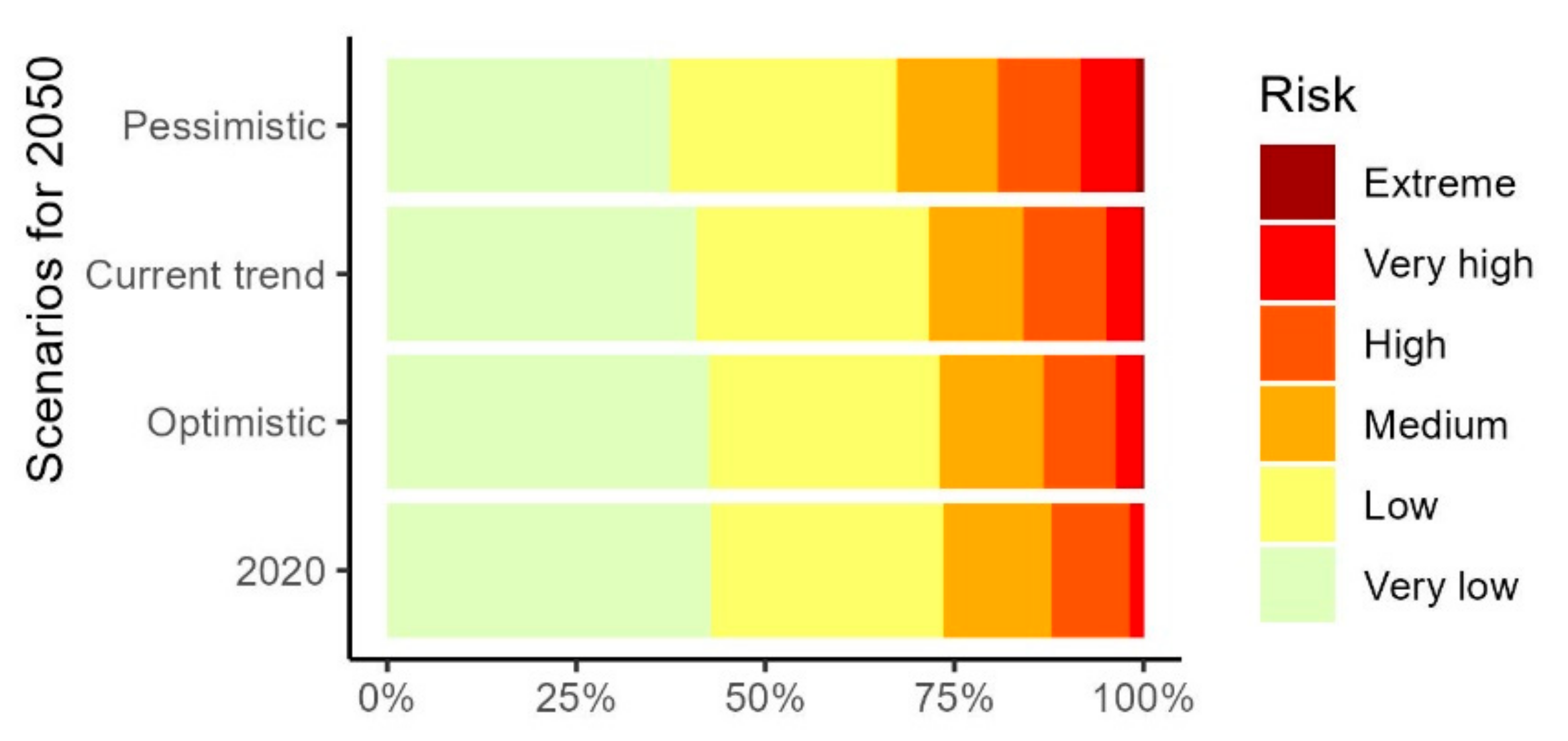
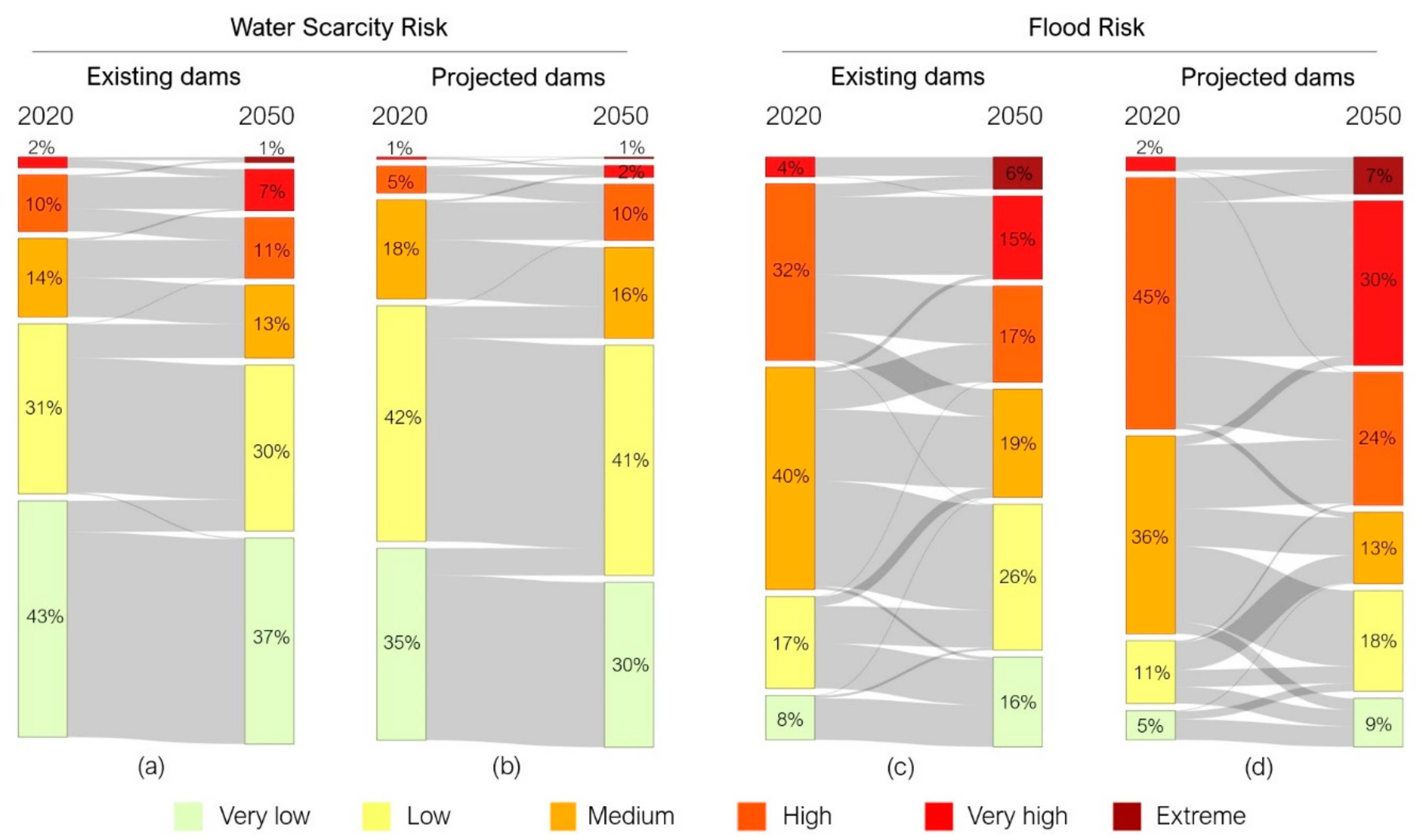
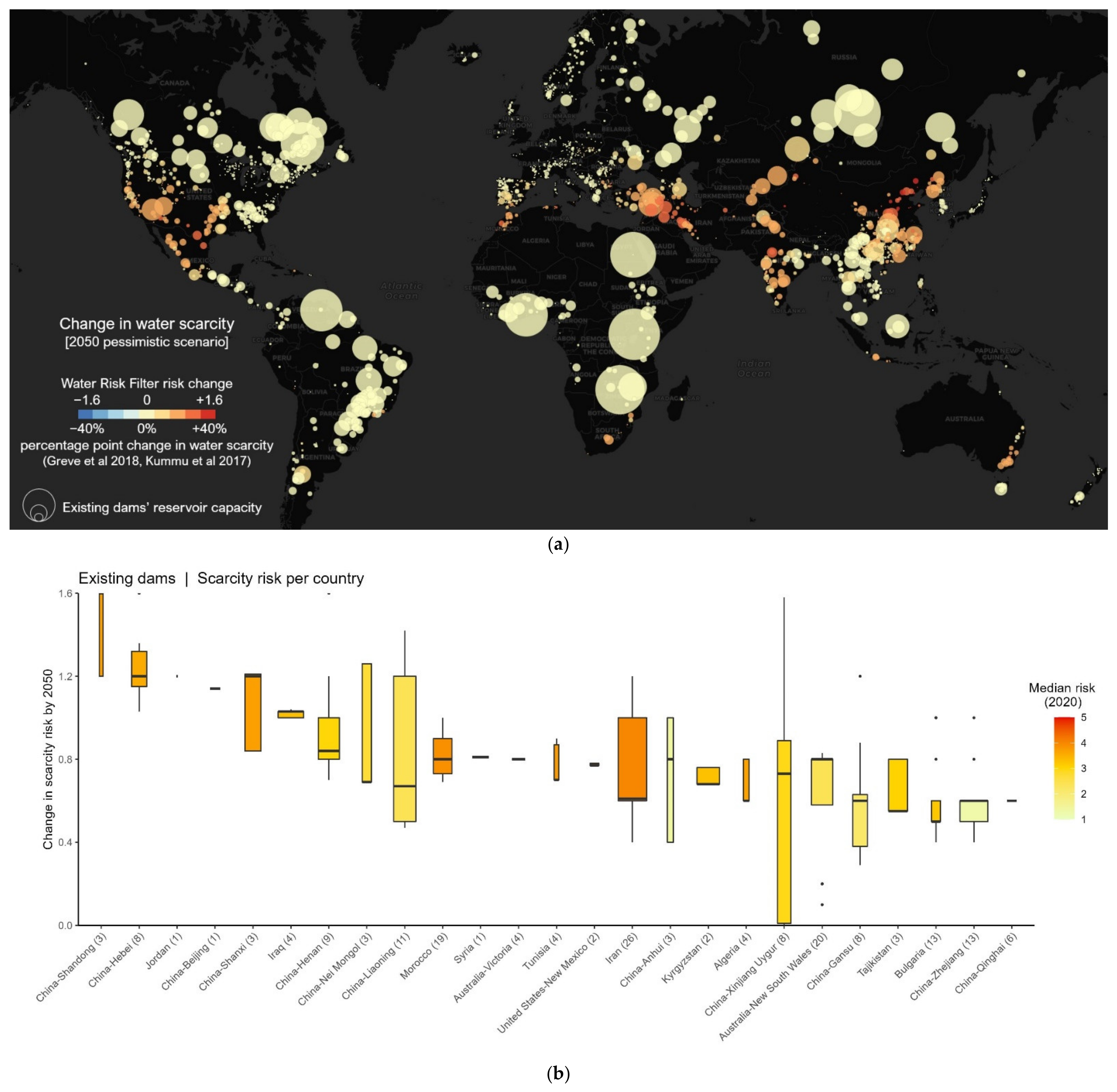
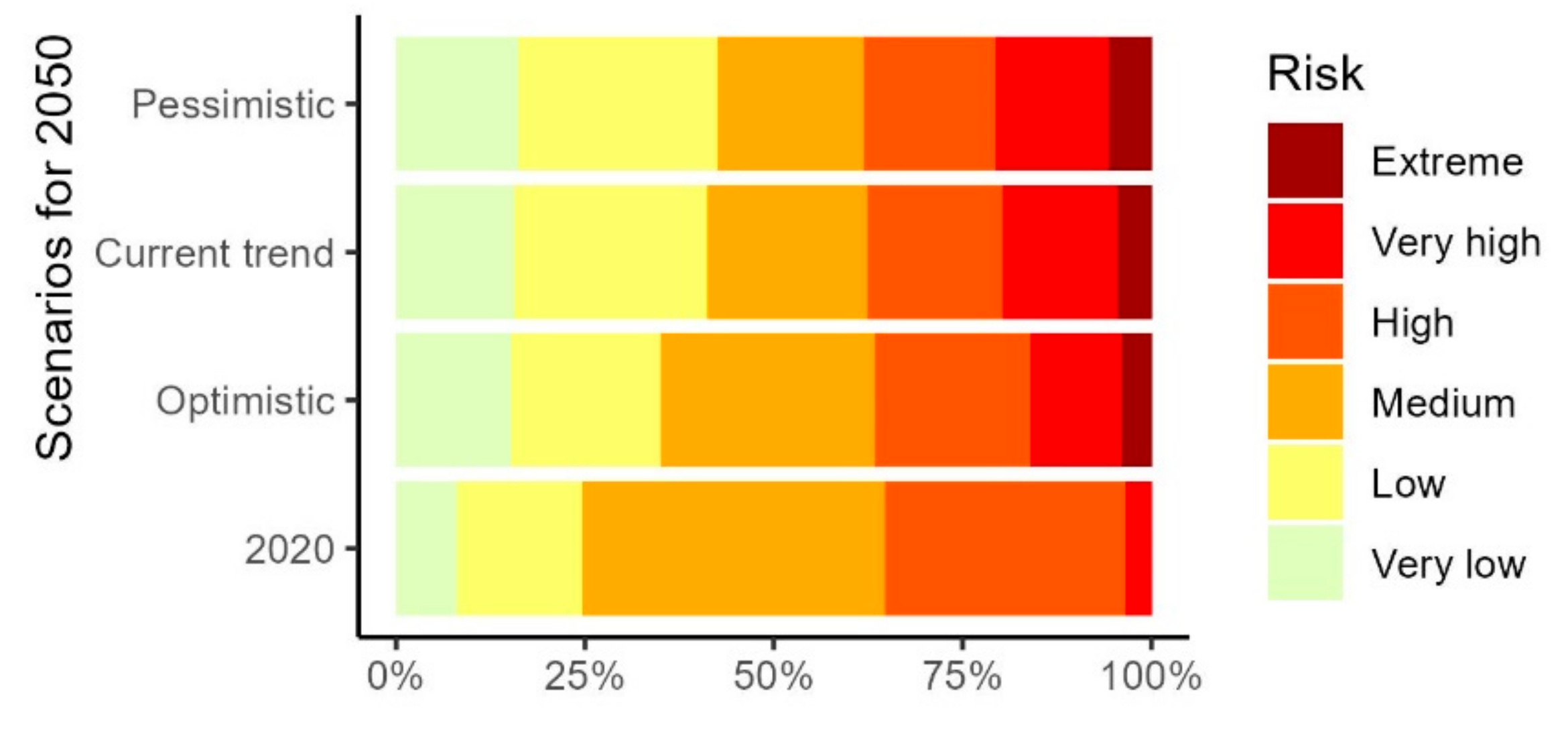
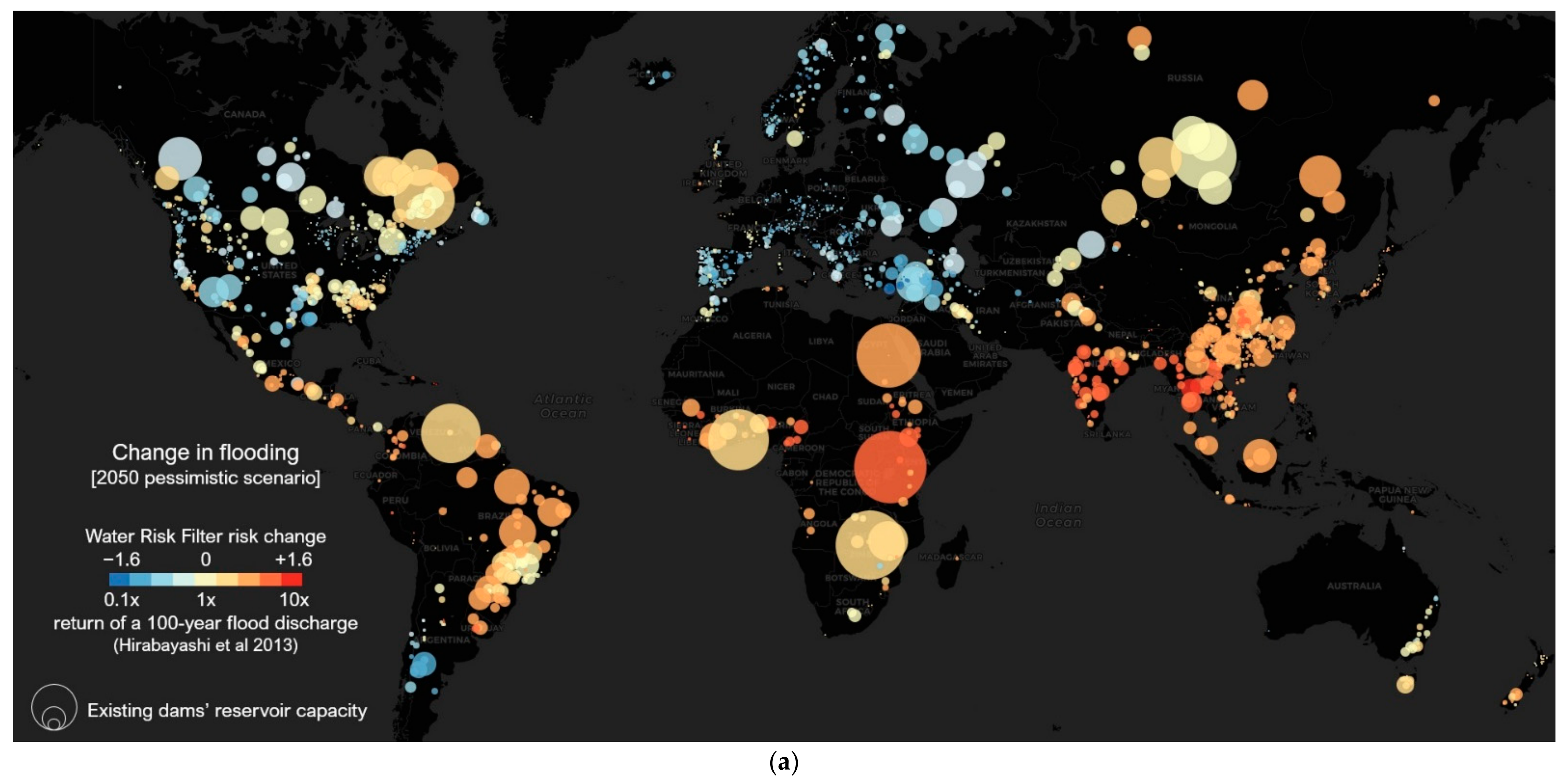
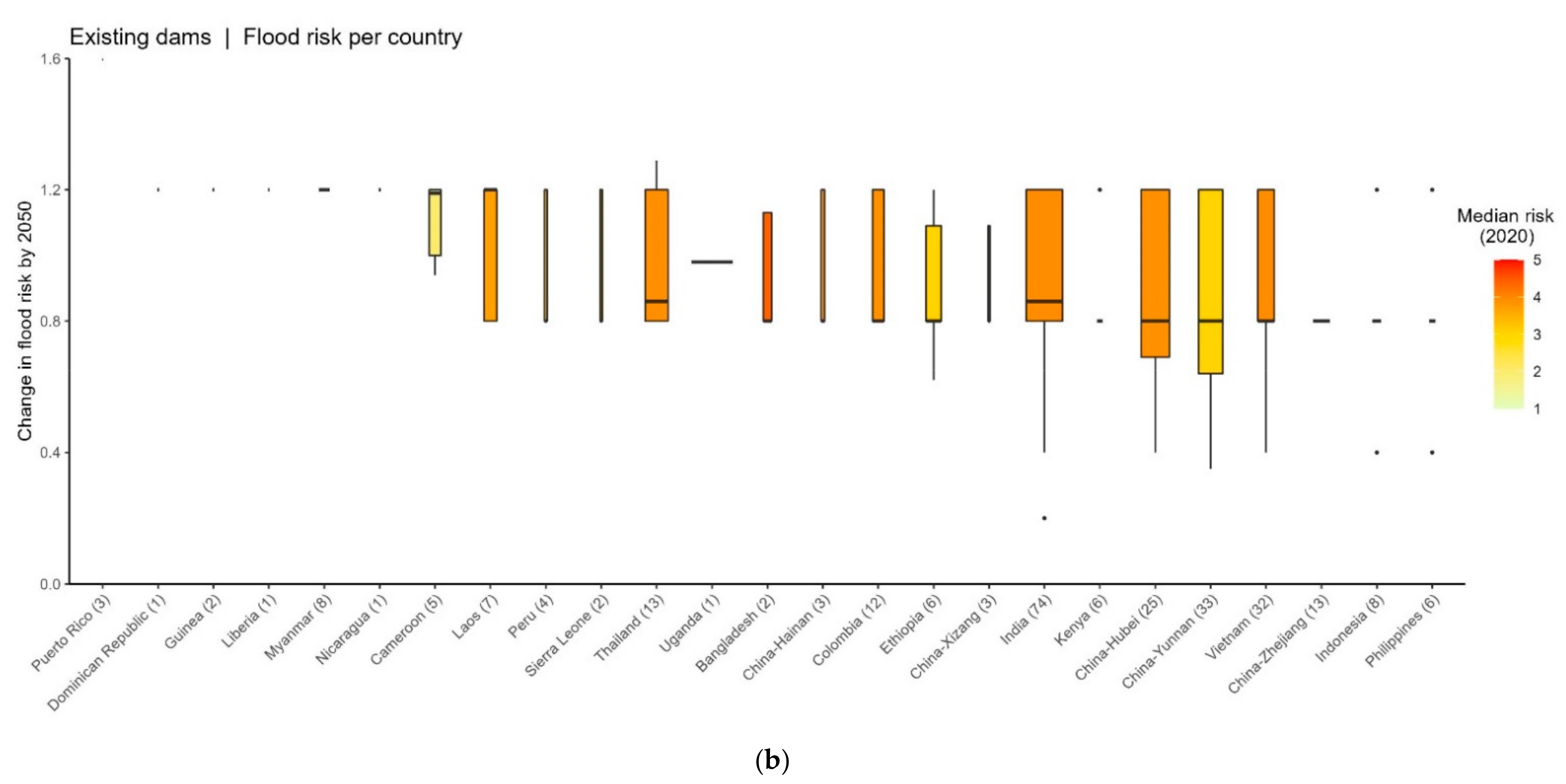
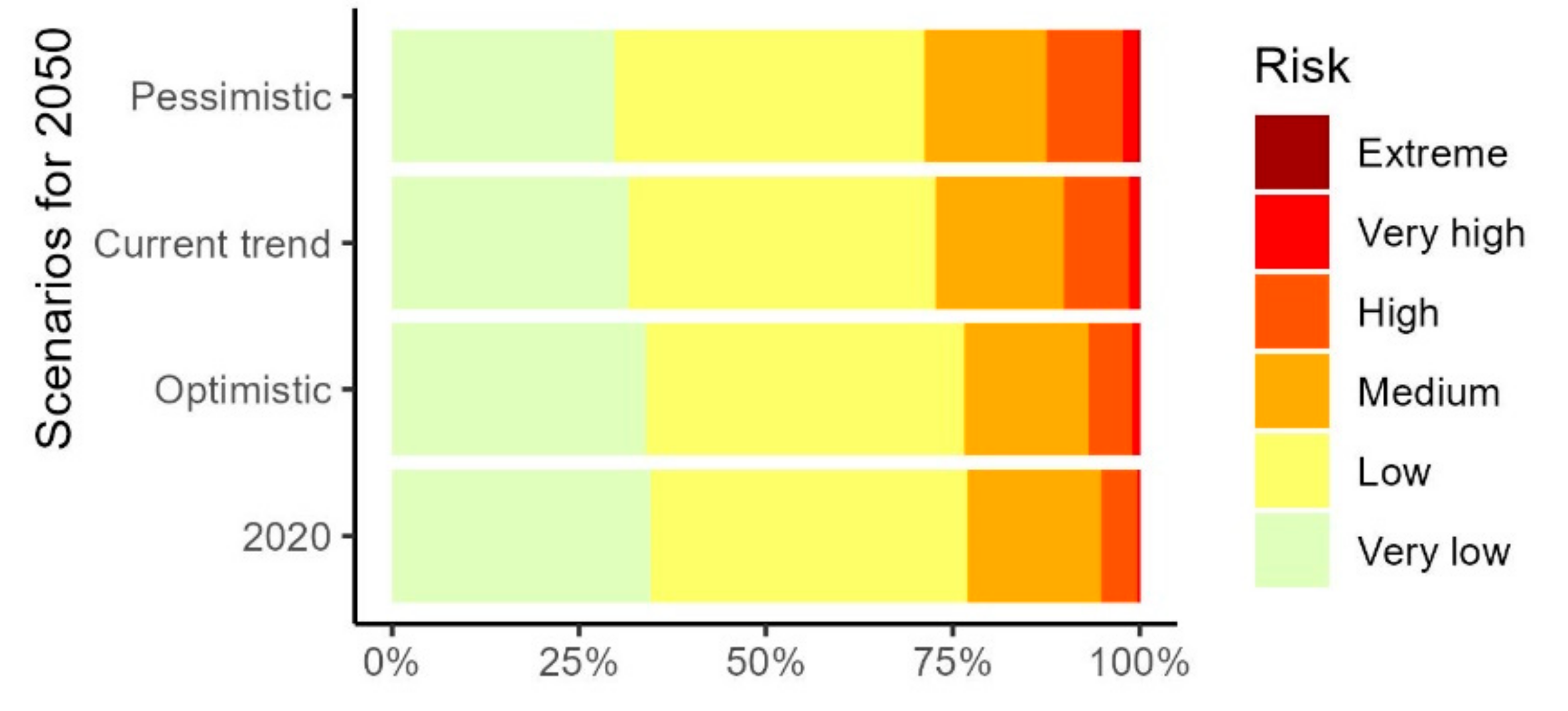
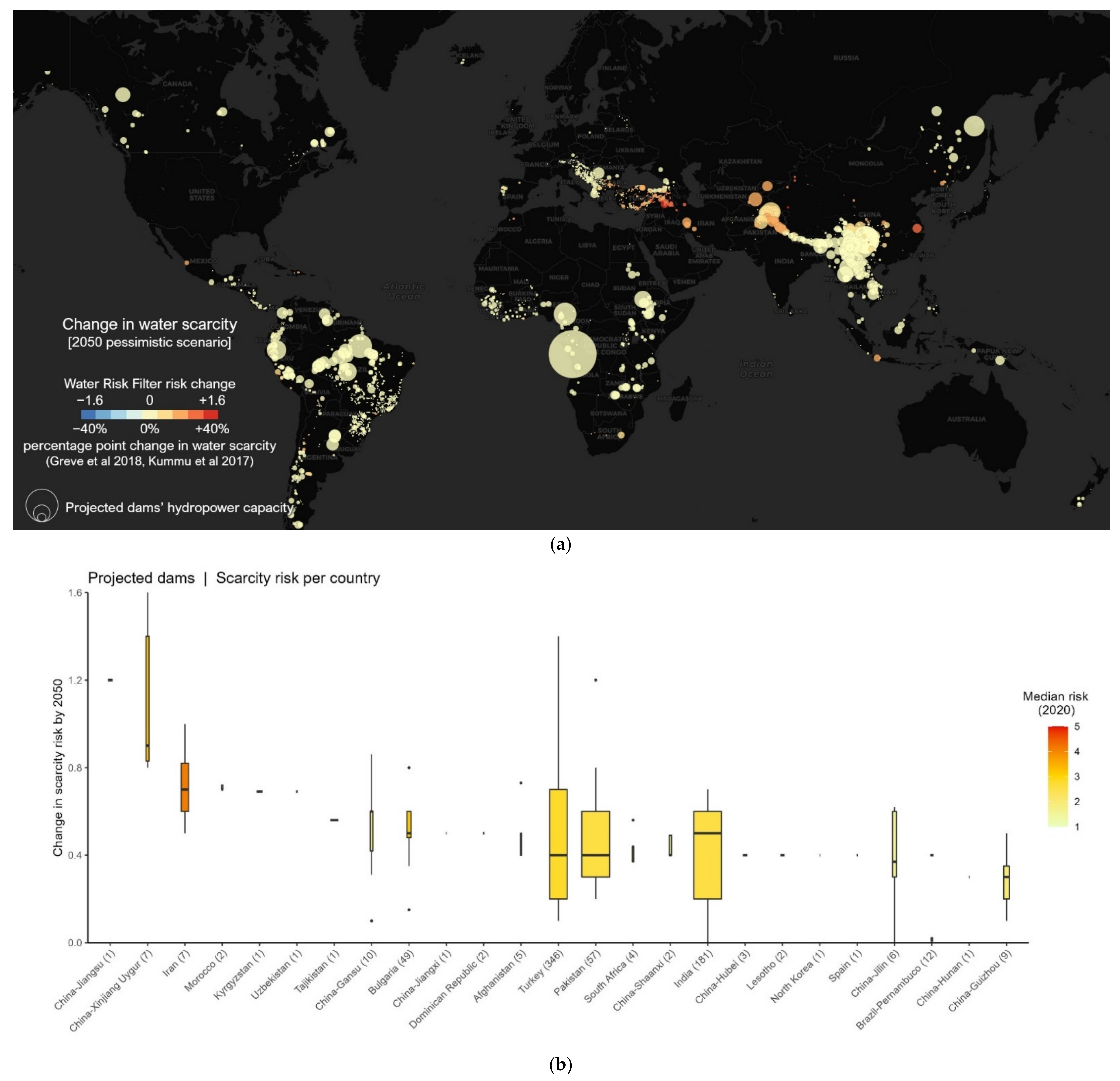
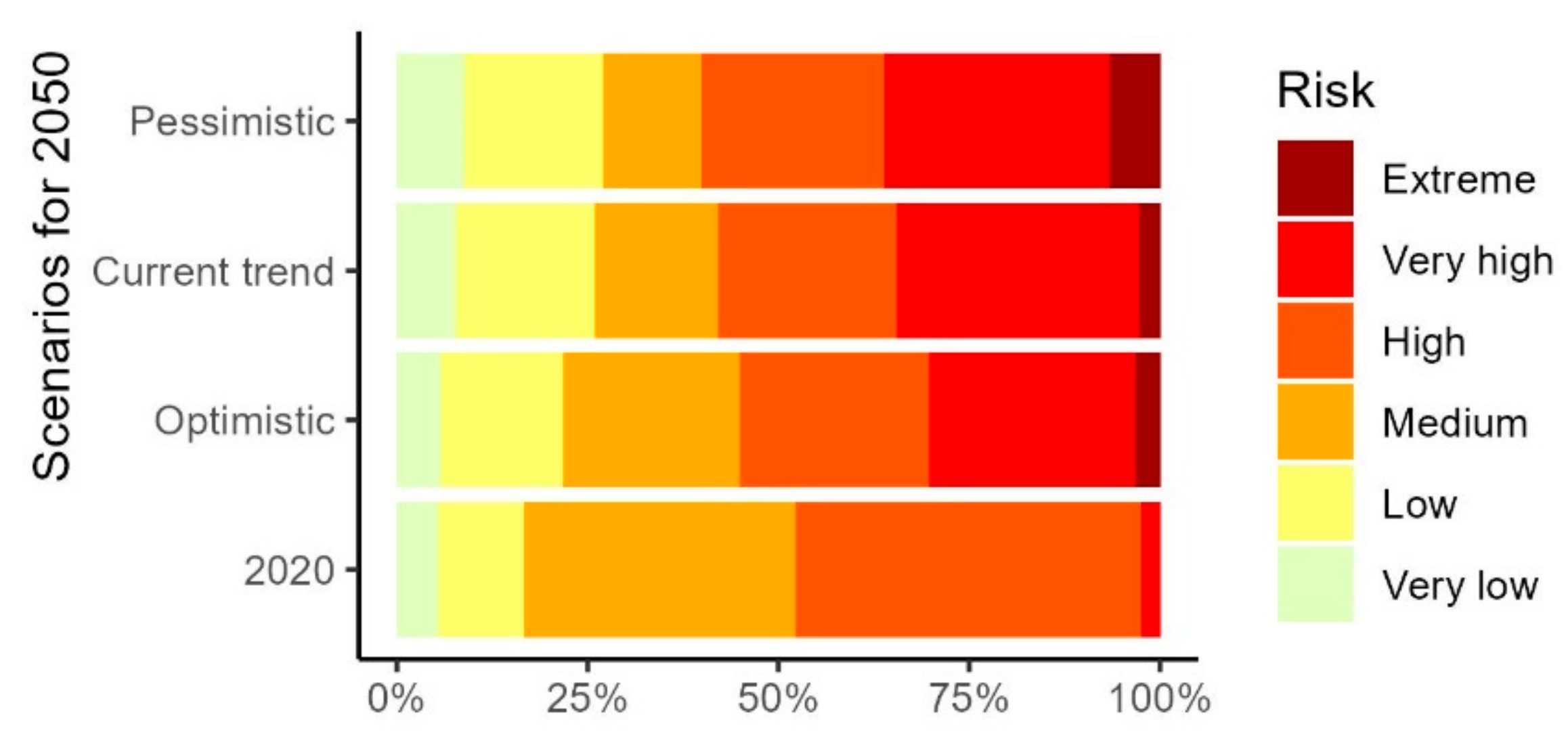
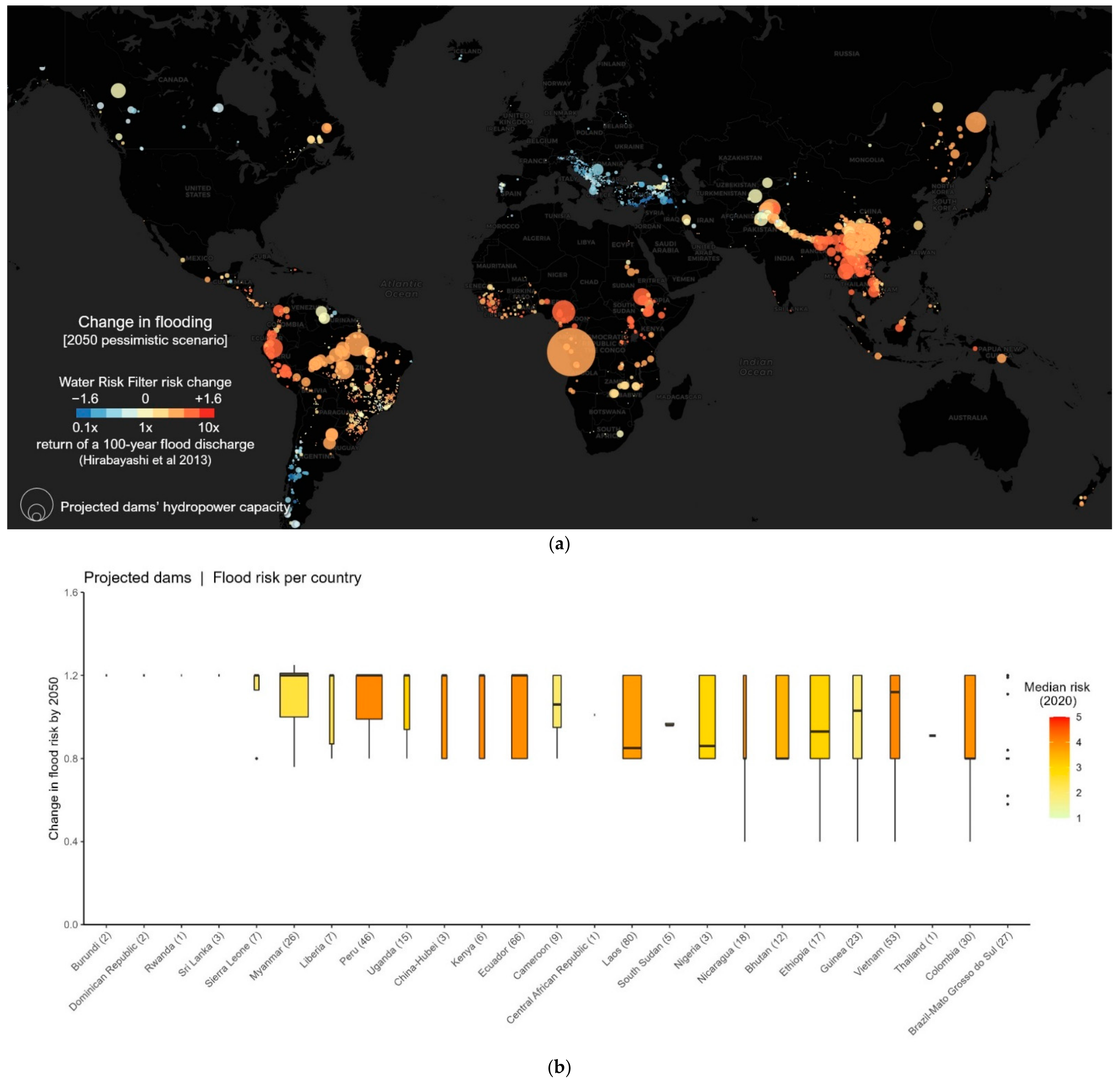
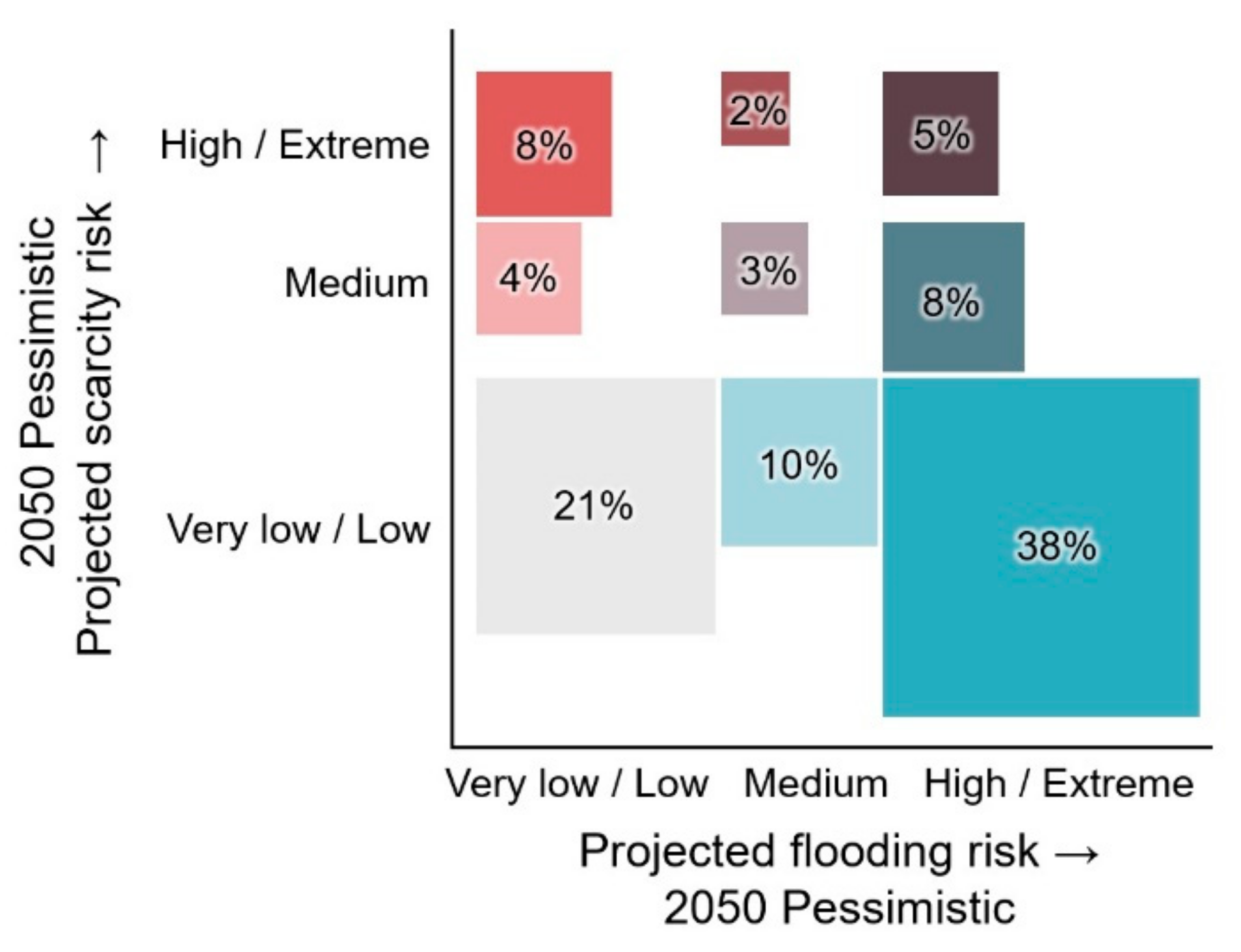
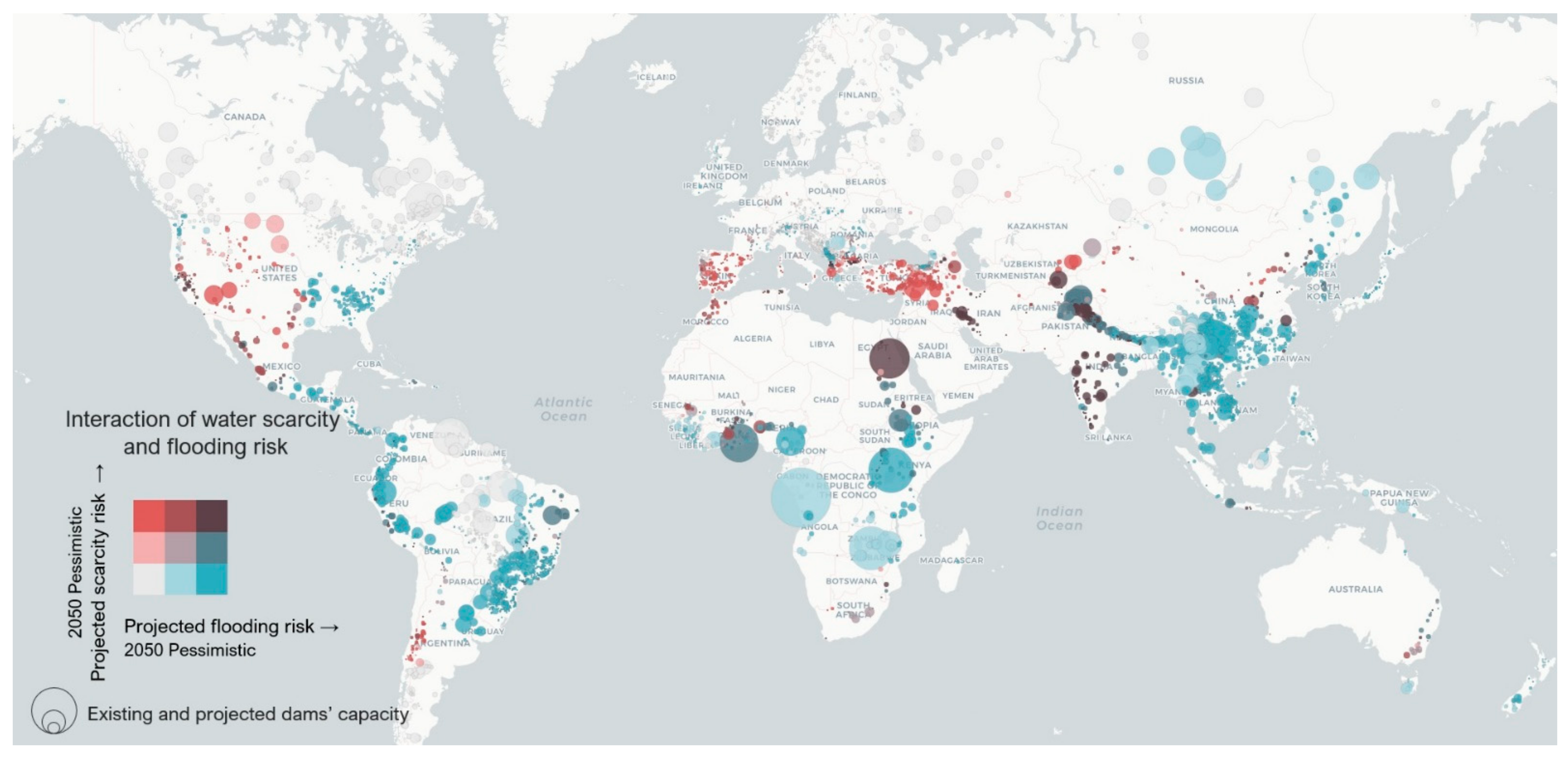

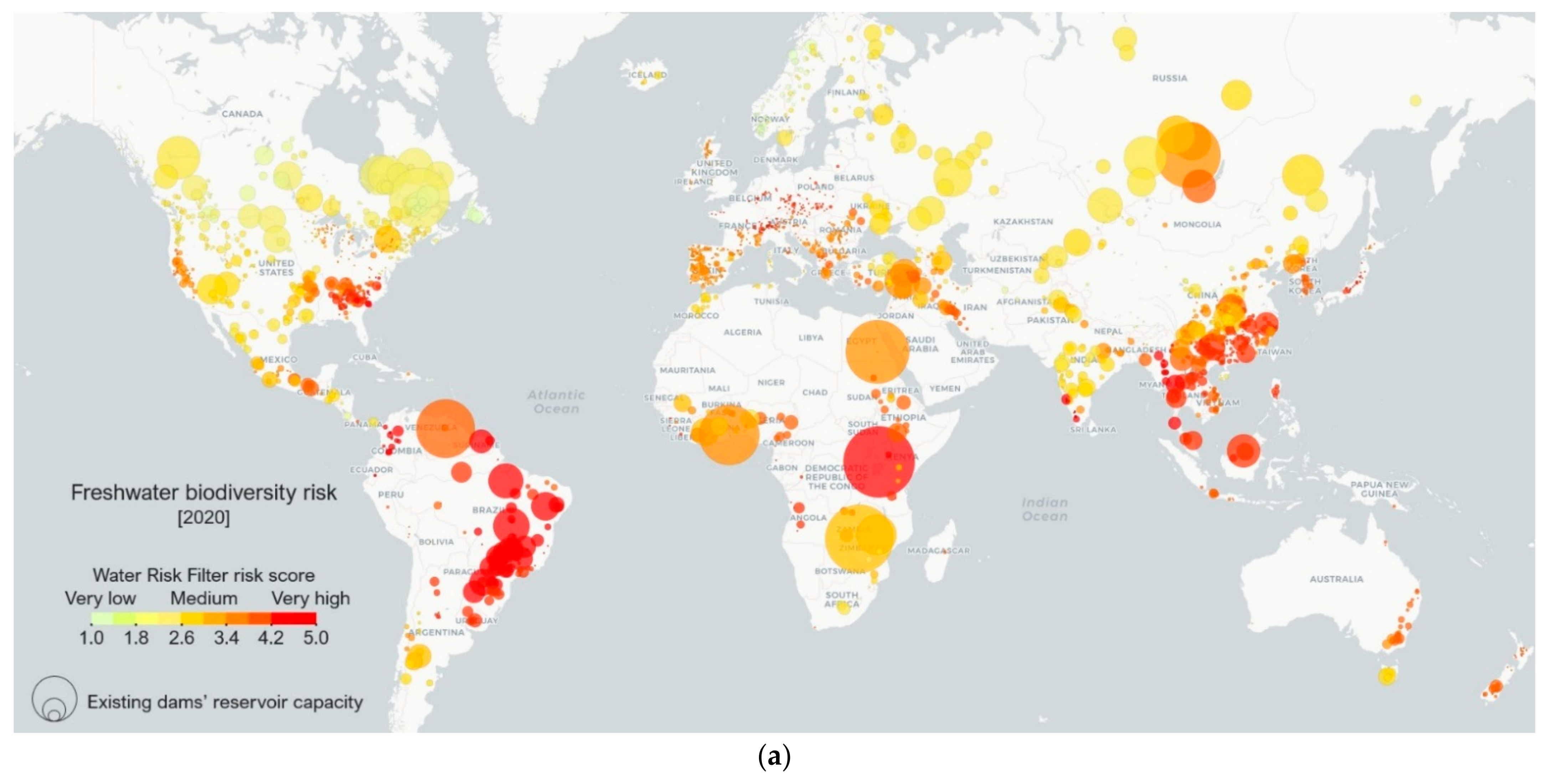
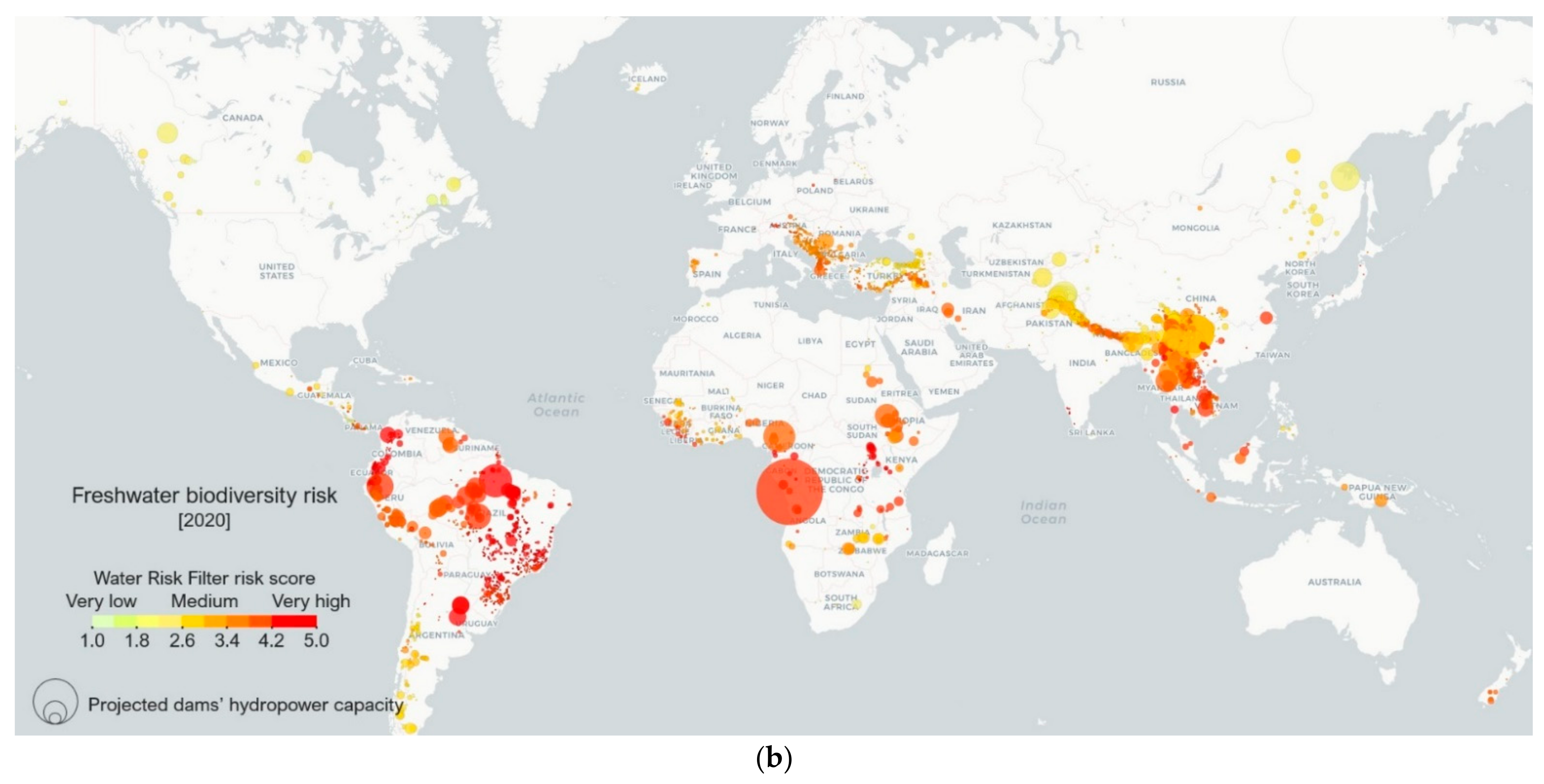
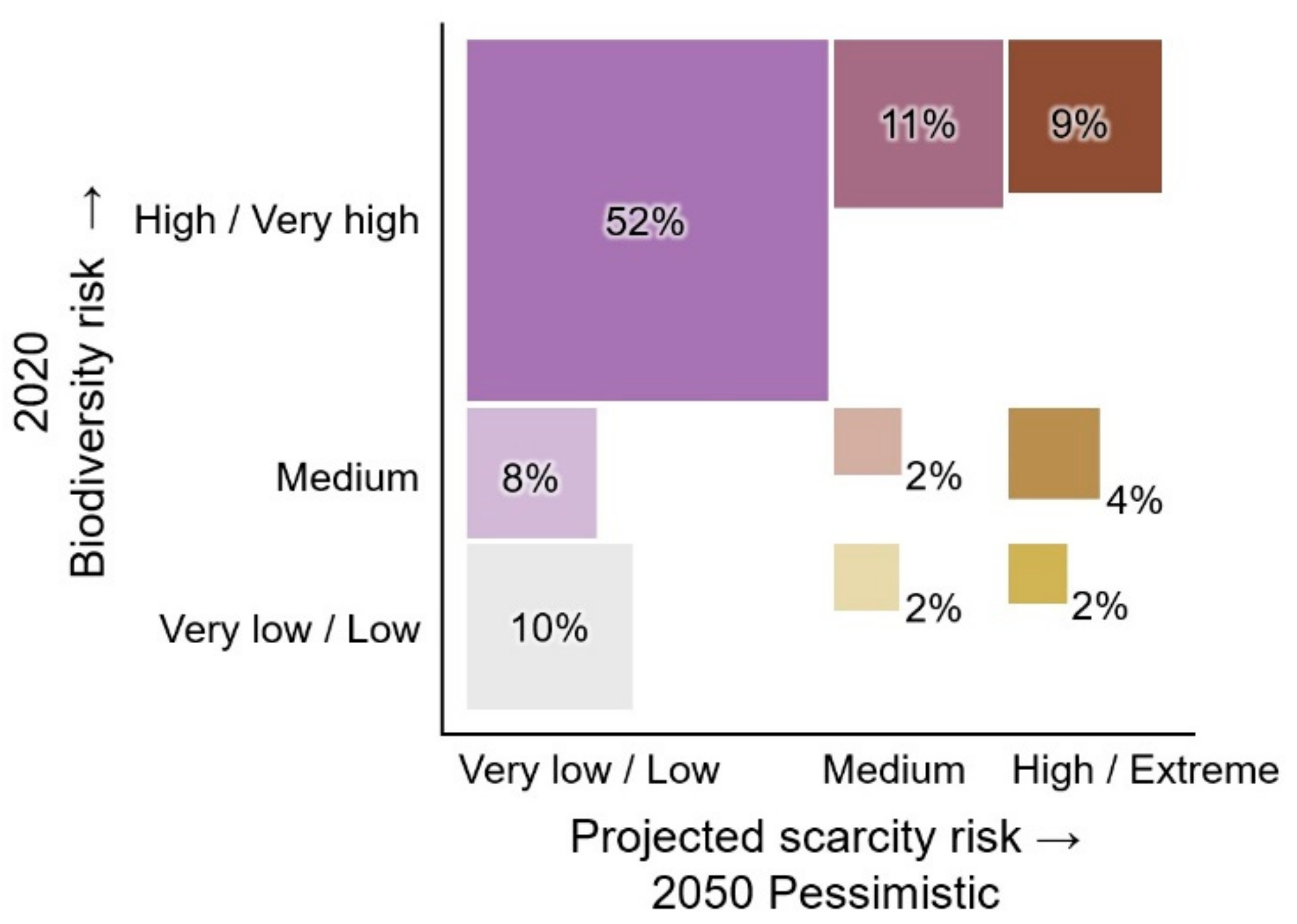
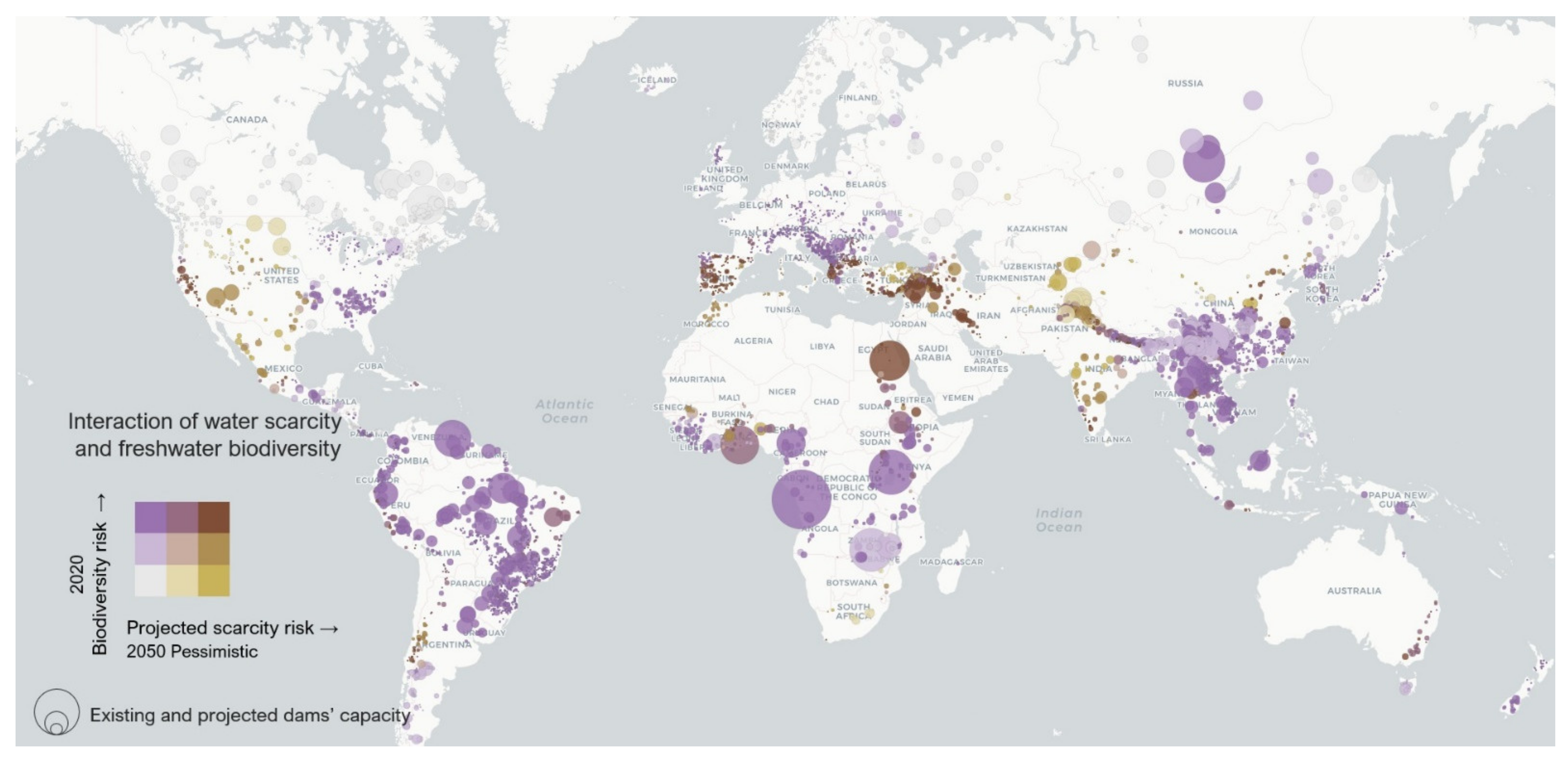
Publisher’s Note: MDPI stays neutral with regard to jurisdictional claims in published maps and institutional affiliations. |
© 2022 by the authors. Licensee MDPI, Basel, Switzerland. This article is an open access article distributed under the terms and conditions of the Creative Commons Attribution (CC BY) license (https://creativecommons.org/licenses/by/4.0/).
Share and Cite
Opperman, J.J.; Camargo, R.R.; Laporte-Bisquit, A.; Zarfl, C.; Morgan, A.J. Using the WWF Water Risk Filter to Screen Existing and Projected Hydropower Projects for Climate and Biodiversity Risks. Water 2022, 14, 721. https://doi.org/10.3390/w14050721
Opperman JJ, Camargo RR, Laporte-Bisquit A, Zarfl C, Morgan AJ. Using the WWF Water Risk Filter to Screen Existing and Projected Hydropower Projects for Climate and Biodiversity Risks. Water. 2022; 14(5):721. https://doi.org/10.3390/w14050721
Chicago/Turabian StyleOpperman, Jeffrey J., Rafael R. Camargo, Ariane Laporte-Bisquit, Christiane Zarfl, and Alexis J. Morgan. 2022. "Using the WWF Water Risk Filter to Screen Existing and Projected Hydropower Projects for Climate and Biodiversity Risks" Water 14, no. 5: 721. https://doi.org/10.3390/w14050721
APA StyleOpperman, J. J., Camargo, R. R., Laporte-Bisquit, A., Zarfl, C., & Morgan, A. J. (2022). Using the WWF Water Risk Filter to Screen Existing and Projected Hydropower Projects for Climate and Biodiversity Risks. Water, 14(5), 721. https://doi.org/10.3390/w14050721





